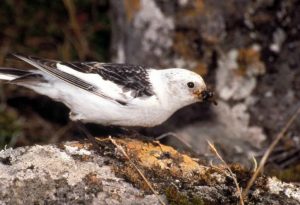Snow bunting
Snow bunting (Plectrophenax nivalis) is the northernmost breeder of any land-based bird, these “snowflakes” are known to inhabit patches of tundra not covered by ice. It is widespread in high Arctic tundra of North America, Ellesmere Island, Iceland, higher mountains of Scotland, Norway, Russia, North Greenland, Siberia.
It’s a hardy, medium-sized songbird of the high Arctic and snowy winter fields. Sometimes known as the ‘snowflake’, its white plumage and dancing flight give its flocks the appearance of swirling snow flurries.
After the molt in the late summer the male looks brownish with a brown and black striped back. Underneath the colored feather tips, the back feathers are pure black and the body feathers all are white. The male wears off all of the feather tips by actively rubbing them on snow, and he is immaculate white and jet black by the time breeding begins.
Males arrive on breeding grounds 3-6 weeks before females, to stake out territories containing suitable nest sites.
This bird places its nest deep in cracks or other cavities in rocks. Although such nest sites are relatively secure from predators, rocks are cold. The thick nest lining of fur and feathers helps keep the eggs and nestlings warm, but the female must remain on the nest for most of the incubation period
Snow bunting’s diet consists of seeds, but in breeding season also small arthropods; young fed only with invertebrates.



 This project (EDU-ARCTIC) has received funding from the European Union’s Horizon 2020 research and innovation programme under grant agreement No 710240. The content of the website is the sole responsibility of the Consortium and it does not represent the opinion of the European Commission, and the Commission is not responsible for any use that might be made of information contained.
This project (EDU-ARCTIC) has received funding from the European Union’s Horizon 2020 research and innovation programme under grant agreement No 710240. The content of the website is the sole responsibility of the Consortium and it does not represent the opinion of the European Commission, and the Commission is not responsible for any use that might be made of information contained.